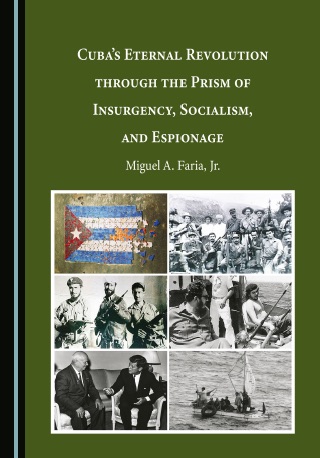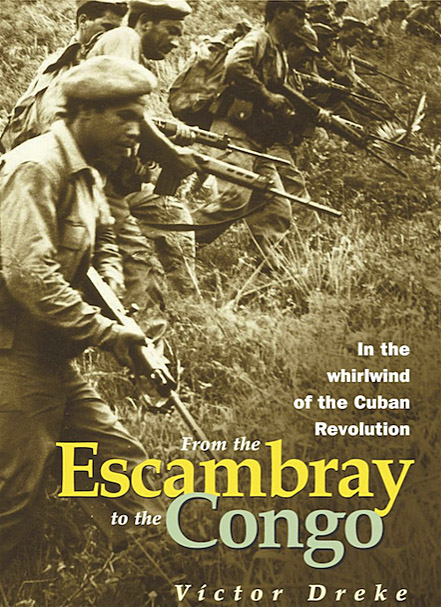
- Articles
Che Guevara and Víctor Dreke in the African Congo by Miguel A. Faria, MD
In April 1965, Víctor Dreke accompanied Che Guevara on his ill-fated expedition to the African Congo. Serving as Che’s second-in-command, Dreke led a company of 128 Cuban fighters that fought in the Congo until November 1965. Their mission was to support Patrice Lumumba’s liberation movement in the eastern Congo against the Congolese government that was considered to be a neocolonial regime. Although Lumumba had been killed in 1961, his Congolese National Movement had been reignited in 1964. The rebels, referred to as Simbas, were trying to overthrow the regime of Moise Tshombe. They considered Tshombe and Joseph Mobutu (later, Mobutu Sese Seko), who was the chief of the Congolese army staff, tools and puppets of the Western “imperialist” powers.

One of the many ironies of the Congo debacle was that even though Dreke’s group was composed mostly of Afro-Cubans like Víctor Dreke and Henry “Pombo” Villegas Tamayo, who was Che Guevara’s chief bodyguard, the Cuban expedition was led by a white Argentinean, Che Guevara. As Dreke explained, “I was given orders to select a group of compañeros for the mission from the Central army…. Furthermore, I was told, the compañeros were to be black—‘very black.’ That was the instruction I was given.” Interestingly, Villegas followed Che to Bolivia in the Argentinean’s final debacle in 1966.
But the Congo adventure rapidly became a misadventure. Following one failure after another, Dreke related that Che blamed himself for the debacle. Among other things, Che regretted not learning Swahili or the various dialects before arriving in the Congo. Apparently, there was nothing Che could do with his Spanish or French.
Furthermore, the Simba rebels frequently did not follow orders or maintain discipline. Instead, a squabble broke out because of tribal differences, and the rebel leaders were not in the front lines, unlike their Cuban military counterparts. Laurent Kabila, the man who orchestrated the 1964 rebellion and was supposed to assist Che in the revolution, was frequently absent. Rebel leaders remained far away from any kind of fighting.
Guevara tried his best to instruct and support Kabila, who had taken over Lumumba’s followers and the rebel Marxist Simba forces, but he found them undisciplined. Although Che had found that of all of the Congolese insurgent leaders only Kabila had “genuine qualities of a mass leader,” he lacked “revolutionary seriousness.” His men were poorly trained. Kabila showed up days late at times to provide supplies and backup for Guevara’s men during combat. Kabila preferred to spend most of his time at local bars or brothels instead of fighting the government forces. The lack of cooperation between Kabila and Guevara was a factor in the defeat of the rebellion in November 1965 and prompted Che’s escape from Africa. For his part, Kabila turned to smuggling gold and timber on Lake Tanganyika, and ran a bar and brothel in Tanzania.

Dreke related that the communist-backed Simba rebels also relied on Dawa, that is, witchcraft and religious rituals that had to have favorable omens before they would fight. As if that was not enough, Dreke further noted, “There were times when we went into battle and the Congolese compañeros who were fighting alongside us just ran away and abandoned their weapons.” But while the Congolese ran away, the Cubans had to withdraw or retreat in order. “Cubans have to retreat with elegance. We can’t run helter-skelter,” Che preached to his confreres. Dreke explained, “Retreating with elegance meant you ran two steps, fired two shots, ran some more, fired two more shots. We couldn’t leave in a stampede, throwing away our weapons, throwing away our shoes, throwing everything away. That was Che’s opinion.”
Another irony of the Congo debacle was that not only were the communist Cuban forces beaten and scattered in the African jungle by Congolese government forces but also drubbed by Company 58 of the 5 Commando Unit led by “Mad Mike” Hoare, the legendary British mercenary, and Rip Robertson of the CIA, and composed of anti-communist Cuban exiles.
Moreover, Che, Dreke and the Afro-Cubans were also horrified to see their Marxist African brothers practicing cannibalism, ferociously devouring the liver, the heart, and other body parts of the fallen enemy in the midst of warfare.
It should be noted that the barbarity continues in the Democratic Republic of Congo. In 2003, United Nations colleagues recovered the bodies of two U.N. officers. The corpses not only had been shot in the head but also the bodies were covered with cigarette burns and their genitalia cut off. In December 2001, in intertribal warfare in Mambasa, there were twelve confirmed cases of cannibalism. Rebels forced villagers to eat the remains of their neighbors, family members to consume relatives, and pregnant women were cut open and their fetuses devoured. The savagery has not subsided. In 2018, a team of human rights experts filed a 126-page report with the U.N. Human Rights Council detailing gruesome attacks, including mass rape, dismemberment, and cannibalism among other atrocities still being committed in regional conflicts in the Democratic Republic of Congo.
Dreke’s attempts to bolster morale among the Cuban troops proved futile. “At a certain point we realized that the thing was lost. That the Congolese themselves had made a decision to end the fighting,” Dreke wrote.
Copyright ©2023 Miguel A. Faria, Jr., M.D.
Excerpted from Chapter 7 of Cuba’s Eternal Revolution through the Prism of Insurgency, Socialism, and Espionage (July 2023) by Dr. Miguel A. Faria, and published by Cambridge Scholars Publishing in Newcastle upon Tyne, United Kingdom. You can order the book from Lauren Blackwell, Admin Assistant, Cambridge Scholars Publishing. It is a beautiful hardback book and for a 25% discount, enter code PROMO25 to redeem or ask for it when you email Lauren at orders@cambridgescholars.com.